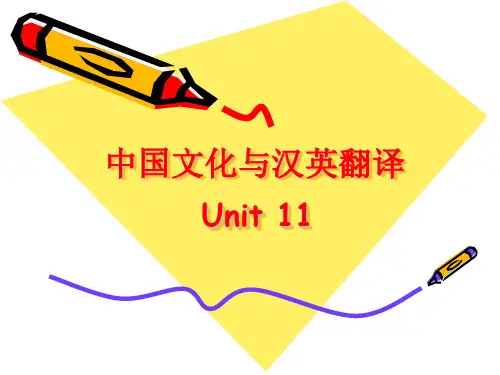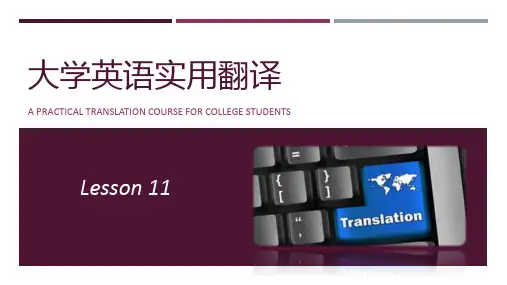英汉翻译教程第十一章
- 格式:ppt
- 大小:133.00 KB
- 文档页数:10
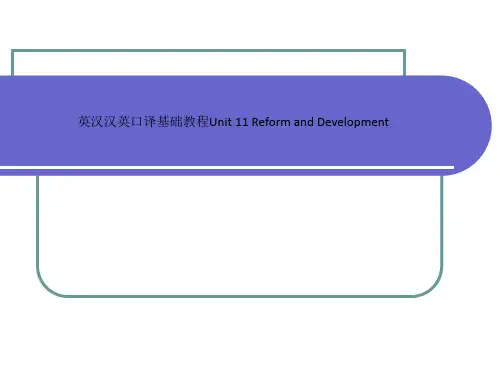
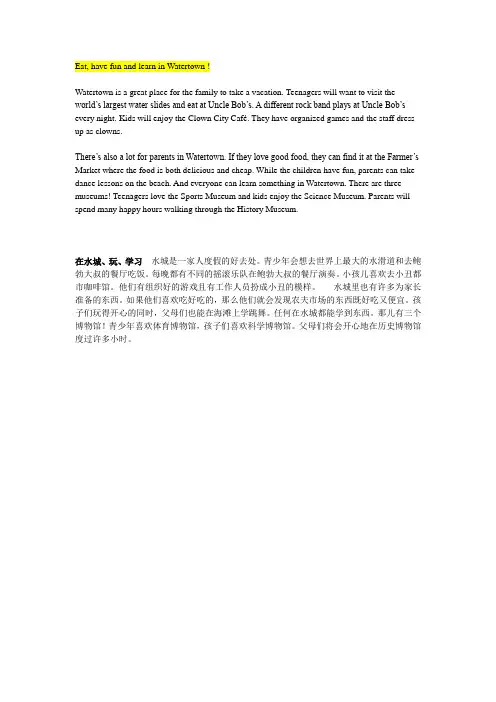
Eat, have fun and learn in Watertown !Watertown is a great place for the family to take a vacation. Teenagers will want to visit the world’s largest water slides and eat at Uncle Bob’s. A different rock band plays at Uncle Bob’s every night. Kids will enjoy the Clown City Café. They have organized games and the staff dress up as clowns.There’s also a lot for parents in Watertown. If they love good food, they can find it at the Farmer’s Market where the food is both delicious and cheap. While the children have fun, parents can take dance lessons on the beach. And everyone can learn something in Watertown. There are three museums! Teenagers love the Sports Museum and kids enjoy the Science Museum. Parents will spend many happy hours walking through the History Museum.在水城、玩、学习水城是一家人度假的好去处。
青少年会想去世界上最大的水滑道和去鲍勃大叔的餐厅吃饭。
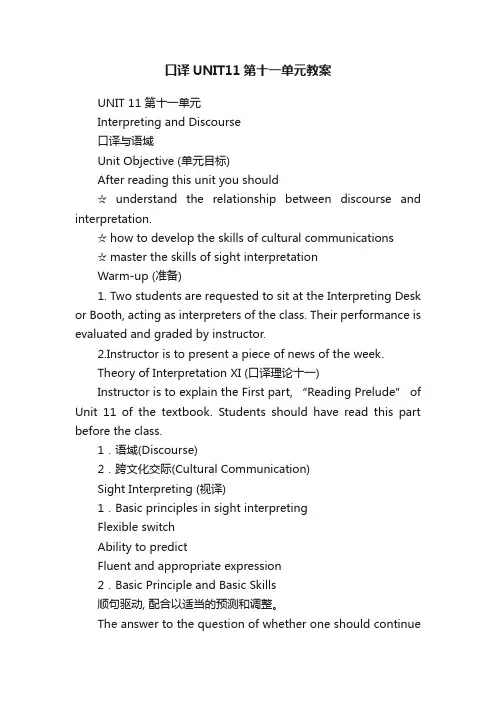
口译UNIT11第十一单元教案UNIT 11 第十一单元Interpreting and Discourse口译与语域Unit Objective (单元目标)After reading this unit you should☆ understand the relationship between discourse and interpretation.☆ how to develop the skills of cultural communications☆ master the skills of sight interpretationWarm-up (准备)1. Two students are requested to sit at the Interpreting Desk or Booth, acting as interpreters of the class. Their performance is evaluated and graded by instructor.2.Instructor is to present a piece of news of the week.Theory of Interpretation XI (口译理论十一)Instructor is to explain the First part, “Reading Prelude” of Unit 11 of the textbook. Students should have read this part before the class.1.语域(Discourse)2.跨文化交际(Cultural Communication)Sight Interpreting (视译)1.Basic principles in sight interpretingFlexible switchAbility to predictFluent and appropriate expression2.Basic Principle and Basic Skills顺句驱动, 配合以适当的预测和调整。
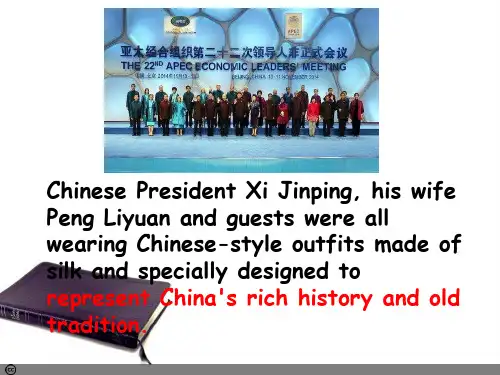
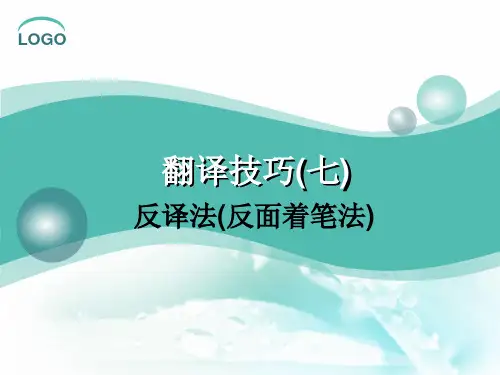
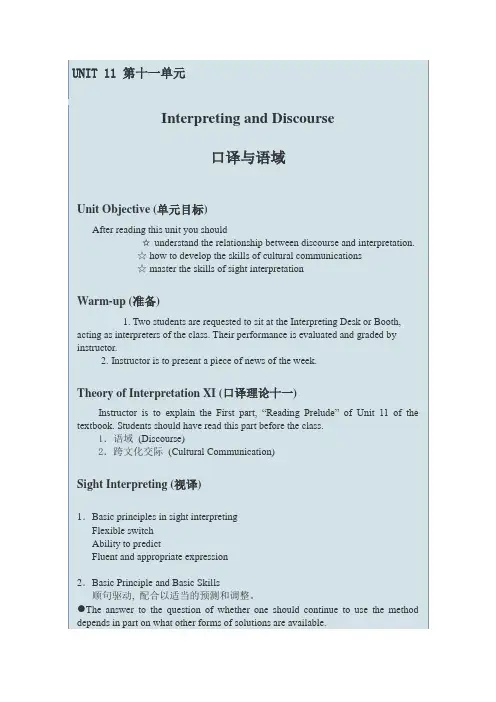
UNIT 11 第十一单元Interpreting and Discourse口译与语域Unit Objective (单元目标)After reading this unit you should☆ understand the relationship between discourse and interpretation.☆ how to develop the skills of cultural communications☆ master the skills of sight interpretationWarm-up (准备)1. Two students are requested to sit at the Interpreting Desk or Booth, acting as interpreters of the class. Their performance is evaluated and graded by instructor.2.Instructor is to present a piece of news of the week.Theory of Interpretation XI (口译理论十一)Instructor is to explain the First part, “Reading Prelude” of Unit 11 of the textbook. Students should have read this part before the class.1.语域(Discourse)2.跨文化交际(Cultural Communication)Sight Interpreting (视译)1.Basic principles in sight interpretingFlexible switchAbility to predictFluent and appropriate expression2.Basic Principle and Basic Skills顺句驱动, 配合以适当的预测和调整。
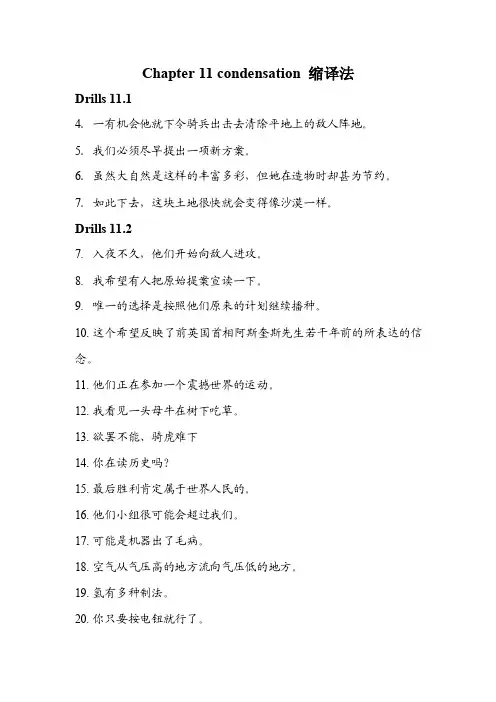
Chapter 11 condensation 缩译法Drills 11.14.一有机会他就下令骑兵出击去清除平地上的敌人阵地。
5.我们必须尽早提出一项新方案。
6.虽然大自然是这样的丰富多彩,但她在造物时却甚为节约。
7.如此下去,这块土地很快就会变得像沙漠一样。
Drills 11.27.入夜不久,他们开始向敌人进攻。
8.我希望有人把原始提案宣读一下。
9.唯一的选择是按照他们原来的计划继续播种。
10.这个希望反映了前英国首相阿斯奎斯先生若干年前的所表达的信念。
11.他们正在参加一个震撼世界的运动。
12.我看见一头母牛在树下吃草。
13.欲罢不能、骑虎难下14.你在读历史吗?15.最后胜利肯定属于世界人民的。
16.他们小组很可能会超过我们。
17.可能是机器出了毛病。
18.空气从气压高的地方流向气压低的地方。
19.氢有多种制法。
20.你只要按电钮就行了。
21.这台电动机投入使用已经一年了。
22.很久以前有一个时期人们不知道如何制出人造光。
23.我们坚信一切客观事实都是可知的。
24.目前我们只能干这件事。
25.苏丹政府认为最紧迫的问题是贫困问题。
26.涡轮机推动发动机发电。
27.有一样东西是吉姆三代祖传的金表。
28.声速一般取决于传声物质的温度。
29.小电流能输送大电量吗?30.矿石通常是指从地球开采出来的有用物质。
31.他们可能从来没有想到竟会有这么大的舆论有利于他们。
32.这是一项适应多方面需要的工程。
33.U-2飞机飞得很高,连在空中或地面都看不见。
34.新飞机明天可能运到。
35.传说这座城市建于公元前15世纪。
36.几乎没有什么地方是没有人生活过或死亡过的。
/ 几乎到处都有人生活过或死亡过。
37.诗歌里的模仿人生或假想人生,是一个条理井然的整体。
38.人生和诗歌的假想人生刚好相反:人生只是零星片段和偶然机遇,没有连贯,没有理路。
Drills 11.33.晚上十点钟,街上来往的车辆稀少了。
4.阿诺河从佛罗伦萨流经比萨如海。
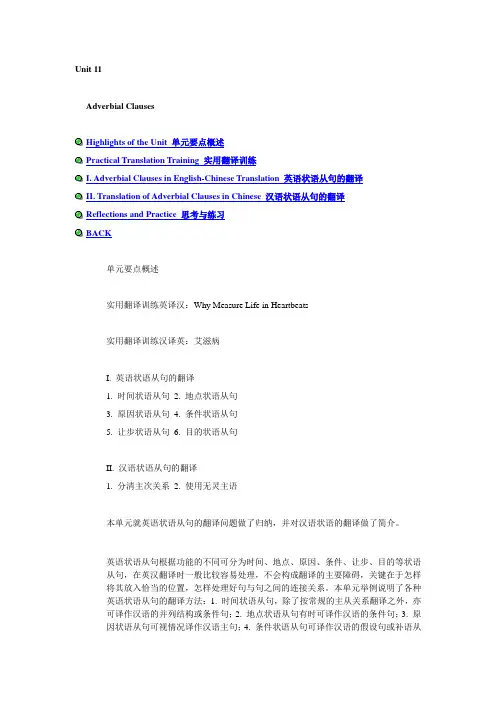
Unit 11Adverbial ClausesHighlights of the Unit 单元要点概述Practical Translation Training 实用翻译训练I. Adverbial Clauses in English-Chinese Translation 英语状语从句的翻译II. Translation of Adverbial Clauses in Chinese 汉语状语从句的翻译Reflections and Practice 思考与练习BACK单元要点概述实用翻译训练英译汉:Why Measure Life in Heartbeats实用翻译训练汉译英:艾滋病I. 英语状语从句的翻译1. 时间状语从句2. 地点状语从句3. 原因状语从句4. 条件状语从句5. 让步状语从句6. 目的状语从句II. 汉语状语从句的翻译1. 分清主次关系2. 使用无灵主语本单元就英语状语从句的翻译问题做了归纳,并对汉语状语的翻译做了简介。
英语状语从句根据功能的不同可分为时间、地点、原因、条件、让步、目的等状语从句,在英汉翻译时一般比较容易处理,不会构成翻译的主要障碍,关键在于怎样将其放入恰当的位置,怎样处理好句与句之间的连接关系。
本单元举例说明了各种英语状语从句的翻译方法:1. 时间状语从句,除了按常规的主从关系翻译之外,亦可译作汉语的并列结构或条件句;2. 地点状语从句有时可译作汉语的条件句;3. 原因状语从句可视情况译作汉语主句;4. 条件状语从句可译作汉语的假设句或补语从句;5. 让步状语从句可译作汉语的“不管”、“无论”之类的无条件句;6. 目的状语从句可根据不同的语气或放在句首,或放在句末。
汉语状语的翻译的关键在于两点:一是分清主次关系;二是学会使用无灵主语。
因为汉语句与句之间往往没有明显的连接词语,句式衔接通过“意合”的机制来实现,讲究“不言而喻”,需要我们潜心把握。
汉语不像英语那样大量地使用无灵名词充当役使主语。
